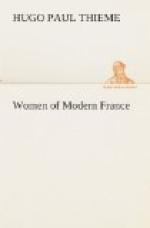When Francis, captured at the battle of Pavia, was taken to Spain, Louise, as regent, displayed unusual diplomatic skill by leaguing the Pope and the Italian states with Francis against the Spanish king. When, after nearly a year’s captivity, her son returned, she welcomed him with a bevy of beauties; among them was a new mistress, designed to destroy the influence of the woman who had so often thwarted the plans of Louise—the beautiful Francoise de Foix whom the king had made Countess of Chateaubriant.
This new beauty was Anne de Pisseleu, one of the thirty children of Seigneur d’Heilly, a girl of eighteen, with an exceptional education. Most cunning was the trap which Louise had set for the king. Anne was surrounded by a circle of youthful courtiers, who hung upon her words, laughed at her caprices, courted her smiles; and when she rather confounded them with the extent of the learning which—with a sort of gay triumph—she was rather fond of showing, they pronounced her “the most charming of learned ladies and the most learned of the charming.”
The plot worked; Francis was fascinated, falling an easy prey to the wiles of the wanton Anne. The former mistress, Francoise de Foix, was discarded, and Louise, purely out of revenge and spite, demanded the return of the costly jewels given by the king and appropriated them herself.
The duty assigned to the new mistress was that of keeping Francis busy with fetes and other amusements. While he was thus kept under the spell of his enchantress, he lost all thought of his subjects and the welfare of his country and the affairs of the kingdom fell into the hands of Louise and her chancellor, Duprat. The girl-mistress, Anne, was married by Louise to the Duc d’Etampes whose consent was gained through the promise of the return of his family possessions which, upon his father’s departure with Charles of Bourbon, had been confiscated.
The reign of Louise of Savoy was now about over; she had accomplished everything she had planned. She had caused Charles of Bourbon, one of the greatest men of the sixteenth century, to turn against his king; and that king owed to her—his mother—his defeat at Pavia, his captivity in Spain, and his moral fall. Spain, Italy, and France were victims of the infamous plotting and disastrous intrigues of this one woman whose death, in 1531, was a blessing to the country which she had dishonored.
At the time of the marriage of Francis I. to Eleanor of Portugal (one of the last acts of Louise), Europe was beginning to look upon France as ahead of all other nations in the “superlativeness of her politeness.” The most rigid etiquette and the most punctilious politeness were always observed, fines being imposed for any discourtesy toward women.




